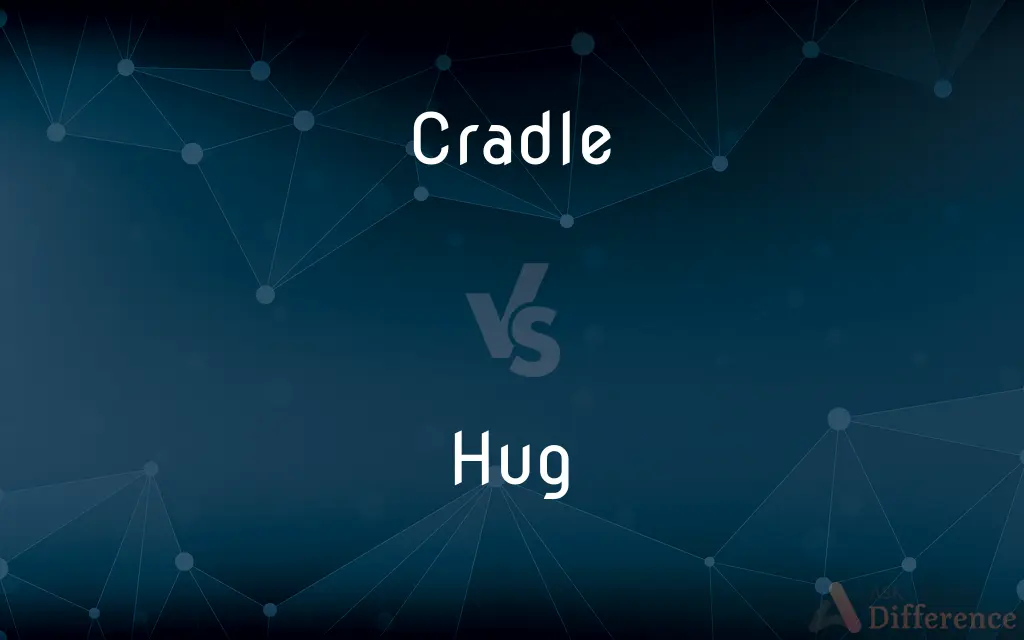Cradle vs. Hug — What's the Difference?
By Tayyaba Rehman & Fiza Rafique — Updated on March 14, 2024
Cradle involves gently holding or supporting, often with a protective embrace, while a hug is a warm embrace between people to show affection or comfort.

Difference Between Cradle and Hug
Table of Contents
ADVERTISEMENT
Key Differences
Cradling is a tender act often associated with holding a baby or something fragile with care and affection, ensuring support and safety. Whereas a hug is a universal gesture of warmth and affection between two people, often encompassing comfort, love, or friendship without the implicit need for protection.
While cradling can be seen as a nurturing gesture that involves a certain posture or way of holding that provides comfort and security, hugging is typically a mutual act where both parties share a close physical connection, expressing emotions such as love, joy, or consolation.
Cradling is more specific in its application, commonly used to refer to the way one holds infants, animals, or even objects delicately, suggesting a level of responsibility and care. On the other hand, hugging is a versatile expression of affection that transcends age, relationship, and sometimes even species, without necessarily implying the act of protecting or nurturing.
The intention behind cradling often relates to providing a sense of security and comfort, emphasizing the caretaker's role in the well-being of the cradled. Meanwhile, hugging serves as a powerful tool for emotional exchange, capable of conveying support, solidarity, or shared joy among equals.
Cradling might involve a more passive interaction from the one being cradled, as it usually involves infants or objects that cannot reciprocate the gesture. In contrast, hugs are generally an interactive exchange, where both participants actively contribute to the embrace, enhancing the sense of connection and mutual care.
ADVERTISEMENT
Comparison Chart
Primary Association
Nurturing, protection
Affection, comfort
Typical Context
Holding infants, fragile items
Emotional support, greetings, farewells
Emotional Connotation
Care, protection
Love, friendship, consolation
Reciprocity
Often one-sided
Mutual
Physical Posture
Supportive, often with arms forming a protective embrace
Embracing closely, often with arms around each other
Compare with Definitions
Cradle
To hold gently and protectively, especially in one's arms.
She cradled the newborn, rocking him gently to sleep.
Hug
To embrace someone tightly with both arms as a sign of affection.
They shared a long hug after being apart for months.
Cradle
To envelop in a manner that provides security.
The hammock cradled him as he lay looking at the stars.
Hug
A physical demonstration of affection that can comfort or reassure.
The small child ran to hug her mother after her first day of school.
Cradle
To support or hold carefully and gently.
He cradled the ancient vase with utmost care.
Hug
An expression of love, friendship, or solidarity.
The team members hugged each other in celebration of their victory.
Cradle
A protective or nurturing way of holding something fragile.
The nurse cradled the patient's head as she administered the medicine.
Hug
A gesture of warmth and comfort towards another person.
After hearing the bad news, she gave her friend a comforting hug.
Cradle
To provide a comforting or secure embrace.
She cradled her pet, calming it during the thunderstorm.
Hug
To encircle or hold closely in one's arms.
He hugged his daughter tightly as she cried.
Cradle
A small low bed for an infant, often furnished with rockers.
Hug
A hug is a form of endearment, universal in human communities, in which two or more people put their arms around the neck, back, or waist of one another and hold each other closely. If more than two people are involved, it may be referred to as a group hug.
Cradle
The earliest period of life
Had an interest in music almost from the cradle.
Hug
Squeeze (someone) tightly in one's arms, typically to express affection
He hugged her close to him
We hugged and kissed
People kissed and hugged each other
Cradle
A place of origin; a birthplace
The cradle of civilization.
Hug
An act of holding someone tightly in one's arms, typically to express affection
There were hugs and tears as they were reunited
Cradle
A framework of wood or metal used to support something, such as a ship undergoing construction or repair.
Hug
To clasp or hold closely, especially in the arms, as in affection; embrace.
Cradle
A framework used to protect an injured limb.
Hug
To hold steadfastly to; cherish
He still hugs his outmoded beliefs.
Cradle
A low flat framework that rolls on casters, used by a mechanic working beneath an automobile. Also called creeper.
Hug
To stay close to
A sailboat hugging the shore.
Cradle
The part of a telephone that contains the connecting switch upon which the receiver and mouthpiece unit is supported.
Hug
To embrace or cling together closely.
Cradle
A frame projecting above the blade of a scythe, used to catch grain as it is cut so that it can be laid flat.
Hug
A close, affectionate embrace.
Cradle
A scythe equipped with such a frame.
Hug
A crushing embrace, as in wrestling.
Cradle
A boxlike device furnished with rockers, used for washing gold-bearing dirt.
Hug
A close embrace, especially when charged with such an emotion as represented by: affection, joy, relief, lust, anger, aggression, compassion, and the like, as opposed to being characterized by formality, equivocation or ambivalence (a half-embrace or "little hug").
Cradle
To place or retain in a cradle.
Hug
A particular grip in wrestling.
Cradle
To care for or nurture in infancy.
Hug
To crouch; huddle as with cold.
Cradle
To hold or support protectively
Cradled the cat in his arms.
Hug
(intransitive) To cling closely together.
Cradle
(Sports) In hockey, to keep possession of (the puck) by moving the stick back and forth to prevent the puck from sliding away.
Hug
(transitive) To embrace by holding closely, especially in the arms.
Billy hugged Danny until he felt better.
Cradle
(Sports) In lacrosse, to keep possession of (the ball) by moving the stick back and forth to prevent the ball from falling to the ground or resting too low in the webbing for easy release.
Hug
(transitive) To stay close to (the shore etc.)
Cradle
To reap (grain) with a cradle.
Hug
To hold fast; to cling to; to cherish.
Cradle
To place or support (a ship, for example) in a cradle.
Hug
To cower; to crouch; to curl up.
Cradle
To wash (gold-bearing dirt) in a cradle.
Hug
To crowd together; to cuddle.
Cradle
A bed or cot for a baby, oscillating on rockers or swinging on pivots.
Hug
To press closely within the arms; to clasp to the bosom; to embrace.
Cradle
(figuratively) The place of origin, or in which anything is nurtured or protected in the earlier period of existence.
A cradle of crime
The cradle of liberty
Hug
To hold fast; to cling to; to cherish.
We hug deformities if they bear our names.
Cradle
(figuratively) Infancy, or very early life.
From the cradle to the grave
Hug
To keep close to; as, to hug the land; to hug the wind.
Cradle
An implement consisting of a broad scythe for cutting grain, with a set of long fingers parallel to the scythe, designed to receive the grain, and to lay it evenly in a swath.
Hug
A close embrace or clasping with the arms, as in affection or in wrestling.
Cradle
A tool used in mezzotint engraving, which, by a rocking motion, raises burrs on the surface of the plate, so preparing the ground.
Hug
A tight or amorous embrace;
Come here and give me a big hug
Cradle
A framework of timbers, or iron bars, moving upon ways or rollers, used to support, lift, or carry ships or other vessels, heavy guns, etc., as up an inclined plane, or across a strip of land, or in launching a ship.
Hug
Hug, usually with fondness;
Hug me, please
They embraced
Cradle
A case for a broken or dislocated limb.
Hug
Fit closely or tightly;
She dress hugged her hipds
Cradle
A frame to keep the bedclothes from contact with the sensitive parts of an injured person.
Cradle
(mining) A machine on rockers, used in washing out auriferous earth.
Cradle
(mining) A suspended scaffold used in shafts.
Cradle
(carpentry) A ribbing for vaulted ceilings and arches intended to be covered with plaster.
Cradle
(nautical) A basket or apparatus in which, when a line has been made fast to a wrecked ship from the shore, the people are brought off from the wreck.
The cradle was ill-made. One victim fell into the sea and was lost and the ensuing delay cost three more lives.
Cradle
A rest for the receiver of a telephone, or for certain computer hardware.
He slammed the handset into the cradle.
Cradle
(contact juggling) A hand position allowing a contact ball to be held steadily on the back of the hand.
Cradle
A mechanical device for tilting and decanting a bottle of wine.
Cradle
(transitive) To contain in or as if in a cradle.
Cradle
(transitive) To rock a baby to sleep.
Cradle
(transitive) To wrap protectively, to hold gently and protectively.
Cradling the injured man’s head in her arms
Cradle
To lull or quieten, as if by rocking.
Cradle
To nurse or train in infancy.
Cradle
(lacrosse) To rock the lacrosse stick back and forth in order to keep the ball in the head by means of centrifugal force.
Cradle
To cut and lay (grain) with a cradle.
Cradle
To transport a vessel by means of a cradle.
Cradle
To put ribs across the back of (a picture), to prevent the panels from warping.
Cradle
A bed or cot for a baby, oscillating on rockers or swinging on pivots; hence, the place of origin, or in which anything is nurtured or protected in the earlier period of existence; as, a cradle of crime; the cradle of liberty.
The cradle that received thee at thy birth.
No sooner was I crept out of my cradleBut I was made a king, at nine months old.
Cradle
Infancy, or very early life.
From their cradles bred together.
A form of worship in which they had been educated from their cradles.
Cradle
An implement consisting of a broad scythe for cutting grain, with a set of long fingers parallel to the scythe, designed to receive the grain, and to lay it evenly in a swath.
Cradle
A tool used in mezzotint engraving, which, by a rocking motion, raises burrs on the surface of the plate, so preparing the ground.
Cradle
A framework of timbers, or iron bars, moving upon ways or rollers, used to support, lift, or carry ships or other vessels, heavy guns, etc., as up an inclined plane, or across a strip of land, or in launching a ship.
Cradle
A case for a broken or dislocated limb.
Cradle
A machine on rockers, used in washing out auriferous earth; - also called a rocker.
Cradle
The ribbing for vaulted ceilings and arches intended to be covered with plaster.
Cradle
The basket or apparatus in which, when a line has been made fast to a wrecked ship from the shore, the people are brought off from the wreck.
Cradle
To lay to rest, or rock, as in a cradle; to lull or quiet, as by rocking.
It cradles their fears to sleep.
Cradle
To nurse or train in infancy.
He that hath been cradled in majesty will not leave the throne to play with beggars.
Cradle
To cut and lay with a cradle, as grain.
Cradle
To transport a vessel by means of a cradle.
In Lombardy . . . boats are cradled and transported over the grade.
Cradle
To lie or lodge, as in a cradle.
Withered roots and husks wherein the acorn cradled.
Cradle
A baby bed with sides and rockers
Cradle
Where something originated or was nurtured in its early existence;
The birthplace of civilization
Cradle
Birth of a person;
He was taught from the cradle never to cry
Cradle
A trough on rockers used by gold miners to shake earth in water in order to separate the gold
Cradle
Hold gently and carefully;
He cradles the child in his arms
Cradle
Bring up from infancy
Cradle
Hold or place in or as if in a cradle;
He cradled the infant in his arms
Cradle
Cut grain with a cradle scythe
Cradle
Wash in a cradle;
Cradle gold
Cradle
Run with the stick
Common Curiosities
What is the main difference between a cradle and a hug?
The main difference is the intention and posture: cradling is about providing protection and support, often in a nurturing context, while hugging is a mutual expression of affection.
Is a hug always a sign of affection?
Primarily, yes, but it can also signify support, comfort, or solidarity in various contexts.
Which is more intimate, a cradle or a hug?
Intimacy can be present in both, but cradling often suggests a deeper level of care and protection, typically in a caregiver context, whereas hugs denote affection and solidarity.
Can animals understand hugs and cradling?
Many animals can perceive and sometimes reciprocate forms of hugging and cradling as signs of affection and comfort, especially domesticated animals like dogs and cats.
Is it common to cradle objects?
Yes, people often cradle objects that are fragile or precious to them, indicating a level of care and attachment.
Do all cultures embrace hugging?
Hugging practices vary widely among cultures, with some embracing it as a common form of greeting and others reserving it for more intimate or family relations.
Is cradling a learned behavior?
Cradling is often instinctual, particularly in parents and caregivers, but it can also be learned and refined in professional caregiving contexts.
What does a hug symbolize?
A hug can symbolize a range of positive emotions, including love, affection, support, comfort, and solidarity, depending on the context and relationship.
Can a hug be therapeutic?
Yes, hugs can have a therapeutic effect by reducing stress, promoting feelings of happiness and safety through the release of oxytocin, known as the "cuddle hormone."
Share Your Discovery

Previous Comparison
Orthodontia vs. Orthodontics
Next Comparison
Drama vs. RoleplayAuthor Spotlight
Written by
Tayyaba RehmanTayyaba Rehman is a distinguished writer, currently serving as a primary contributor to askdifference.com. As a researcher in semantics and etymology, Tayyaba's passion for the complexity of languages and their distinctions has found a perfect home on the platform. Tayyaba delves into the intricacies of language, distinguishing between commonly confused words and phrases, thereby providing clarity for readers worldwide.
Co-written by
Fiza RafiqueFiza Rafique is a skilled content writer at AskDifference.com, where she meticulously refines and enhances written pieces. Drawing from her vast editorial expertise, Fiza ensures clarity, accuracy, and precision in every article. Passionate about language, she continually seeks to elevate the quality of content for readers worldwide.














































